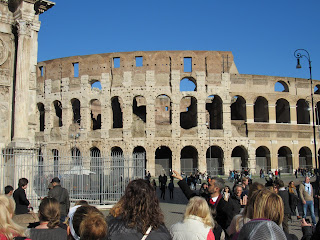Measuring 620 by 513 feet, the Colosseum was the largest amphitheater in the Roman Empire. It was considered an engineering marvel since it was free-standing rather than dug into a hillside as were many amphitheaters of the era. The Colosseum had three stories of arched entrances, each supported with a different style of column - the simplistic Doric on the bottom, Ionic in the middle, and the more ornate Corinthian columns on the top level. The Colosseum seated more than 50,000 spectators, arranged by social class. Awnings covered the top story to protect the citizenry from the burning sun as they watched gladiator combats, hunts, wild animal fights, dramas from mythology, reenactments of famous battles, and mock naval battles (for which the arena was flooded with water). Most gladiators were men, and consisted of slaves, condemned criminals or prisoners of war.
Location: The Colosseum is located in the Piazza del Colosseo, 1, 00184, Rome.
Cost: Tickets cost 12 euros from the official site and includes admission to the Colosseum, Palatine, and current exhibitions. Tours from private venders cost anywhere from $40 - several hundred dollars for VIP service. The cost is 7.50 euros for citizens of the European Union, and free to children under age 18.
Time: Opens at 8:30 am daily. Closing times vary on the season (usually between 3:30-6:30). Allow 1-2 hours to explore, but you might need to arrive early if you take a tour to get through security.
Description: The Colosseum today is a shell of what it used to be in its prime. However, just visiting here gives you a glimpse of what it might have been like to visit during the height of the Roman Empire. You can see the box seats which were reserved for the Emperor (north end) and the Vestal Virgins (south end), flanked by a broad podium for the senatorial class. The names of some fifth century senators can be seen carved into the stonework even today. The tier above the senators was reserved for the non-senatorial nobles. Above them were the wealthy plebeians, followed by the poor plebeians. It isn't hard to draw some parallels to stadium seating today.
 |
| Senatorial section |
The arena measured 272 feet by 157 feet, and was comprised of wooden floorboards covered by sand (arena in Latin). The floorboards and sand are now gone, allowing visitors to get a good view of the hypogeum - or underground network. Although not part of the original construction, the hypogeum was built under the direction of Emperor Domitian and consisted of two levels of tunnels and cages to hold the gladiators and wild animals prior to the contests. Eighty elevator shafts with trap doors allowed easy access to the arena for caged animals or special scenery pieces. Special tunnels allowed the Emperor and the Vestal Virgins to enter and leave without having to pass through the masses. With the addition of the hypogeum, the Colosseum could no longer be flooded for naval battles.
 |
| close up of the hypogeum |
 |
| recreated floor panel with a trap door |
 |
| ruins of nearby support buildings |
Things You Should Know: - I highly recommend taking a tour. A good docent can add so much more detail to what you are seeing, and a better perspective on the lifestyle of the people of that time. However, the official Rome tourism site warns against purchasing from unofficial tour guides on site since they often charge exorbitant prices and aren't officially licensed. The following website has a variety of tours with different prices and times to give you an idea of what's out there.
- There is a museum on the upper floor.
- The ticket booth near the Colosseum has the longest lines. If you purchase your ticket at Palatine Hill, the lines are much shorter.
Nearby: Arch of Constantine, St. Clement Basilica, the Forum, Campidoglio, Altar of the Fatherland
 |
| Arch of Constantine |





No comments:
Post a Comment